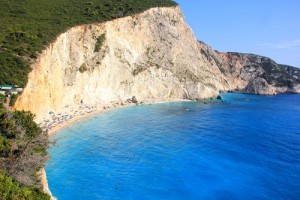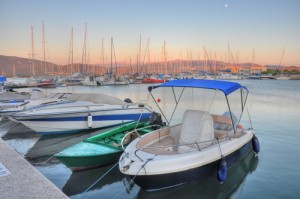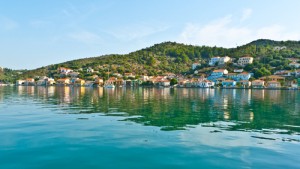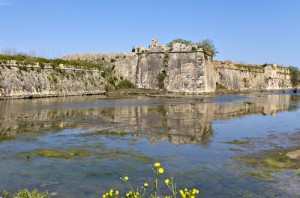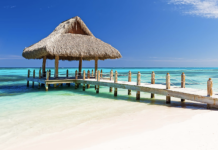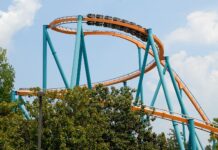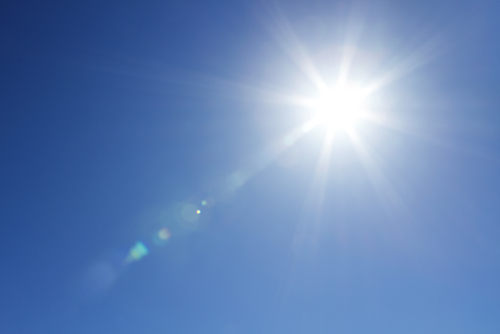The Greek island of Lefkada is easy-going, welcoming and boasts beautiful natural scenery and wonderful weather. In short, it’s the perfect holiday romance. Accessible by causeway over the Drepanos Channel to mainland Greece, this is the only island you can reach by car, a 40-minute journey from Preveza airport. No ferries, no kicking your heels waiting in Athens – you can head straight for the beach.
Beaches are something of a speciality here; indeed Lefkada’s beaches are renowned throughout the Mediterranean. There’s sand on the west side, pebbles on the east and it’s blissfully warm at this time of year, so the clear sparkling sea is inarguably the best place to be. A big bonus is that there seems to be very people around, probably because it’s outside of term time.
I explore a different beach every day and find myself thinking that each is more beautiful than the last. The popular, and more touristy, east side of the island offers beaches off Nidri village, a strip of dusty supermarkets selling fresh vegetables, bars pedaling hearty British breakfasts and shops filled with curly wigs (don’t ask) and bucket and spade knick knacks. Further north, there’s the famously sweeping Vasiliki, but it’s the smaller bays that really provide the thrill of discovery. Poros beach, with its pebbles and buttressed by hills is a 15-minute steep drive from the village of Nidri. There’s an open-sided taverna overlooking the sea serving delicious mezze, and come evening, an elderly local crowd roll up to watch the sun slip away. For good cocktails head to down the road to Syvota Bay, the harbour is laden with chilled-out boat folk drinking on the decks or in the adjacent bars.
The pace is a little quicker in Geni, a bay south of Nidri, where the mood, at least when I am there, is more raucous. On the evening I drop into Taverna Elena for dinner, there’s a Greek birthday party going on across the water with children throwing fire-crackers, and a British birthday party full swing in Elena. The tables go right to the edge of the pier; plenty of customers have fallen in after an indulgent evening – so the restaurant owner tells me. Ouzo really can tip you over the edge…There are tottering folk everywhere this evening, and the little dinghies loaded with party-goers sit very low in the water, but everyone stays on-board; even if they are going round and round in circles.
Boats are popular on this side of the island as the Ionian Sea kicks up only rarely, with swiftly-over swells. Even the most inexperienced sailor can zip around these waters with ease, as Scorpios (the Onassis family’s private island as it happens), Madouri, Sparti and Meganisi mark the horizon and protect this blue hued bay from the wide-open sea. You can take a boat out for the day from Nidri and hone in on empty coves for a swim, avoiding those tantalising spots off Scorpios. The island, said to be uninhabited except for 40 guards, is a no go area. There are places where you can drop anchor for a swim, but most have signs sternly discouraging visitors. It looks artfully manicured, but lifeless.
The island of Meganisi is a more welcoming prospect for a lunch break. Its fishing village, Vathi, has an ordered harbour presided over by orange and lemon houses with neatly flowered gardens. There are plenty of tavernas, but I head to Porto Vathy Errikos, a bona fide family affair. Grandma is in the kitchen, her son is front of house and his daughter is waiting on the tables. Some spirited British sailors are noisily chatting her up – without success. Inside the restaurant are pictures of the owner with his cheerfully sun burnt customers, including the late, much loved actor Pete Postlethwaite.
Back on Lefkada, continuing my beach odyssey, I head into the interior and to the west coast of the island. The roads are precipitous, clouds gather and rain spots. Lush foliage spills over and stalls of honey are the only sign of industry. The beaches on this side are harder work. You can drive down to Gialou, a hot stretch of sand with a striking sea at your fingertips, but not a whisker of shade. Egkremnous beach is reached by steep steps down white-knuckle inducing cliffs – fine if you’re fit. There are larger sandy beaches too, such as Pefkoulia beach, which lurks alluringly beyond scrubby forest.
Culture, is I’m afraid, a footnote on my trip. But there are historic sights worth seeking out. The hilltop monastery of Faneromeni has an ecclesiastical museum with Byzantine icons, old manuscripts and gospels and is said to be the religious heart of the island. The 14th century fortress castle of Agia Mavra near the Channel, just over a km from Hora tells of testier times, when Lefkada required protection. You can also see the ruins of Nirikos, Lefkada’s original capital, 6km from new Lefkas.
It is, though, supremely tempting to just lie on one of those wonderful beaches and slip into that deeply languid sea – so I did.
Guest article written for Monarch.

